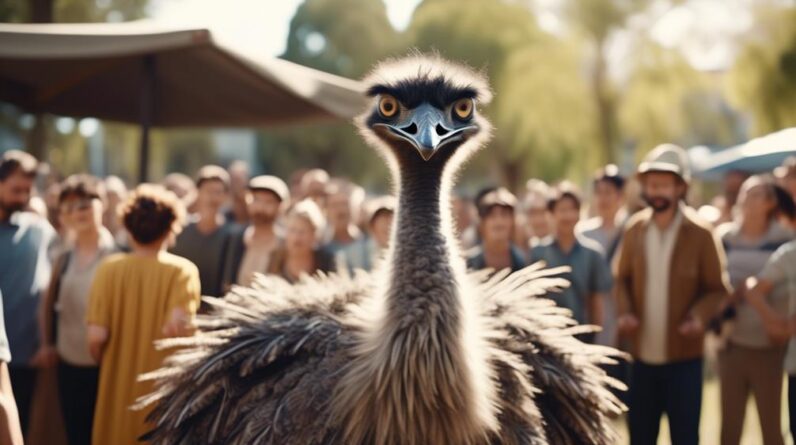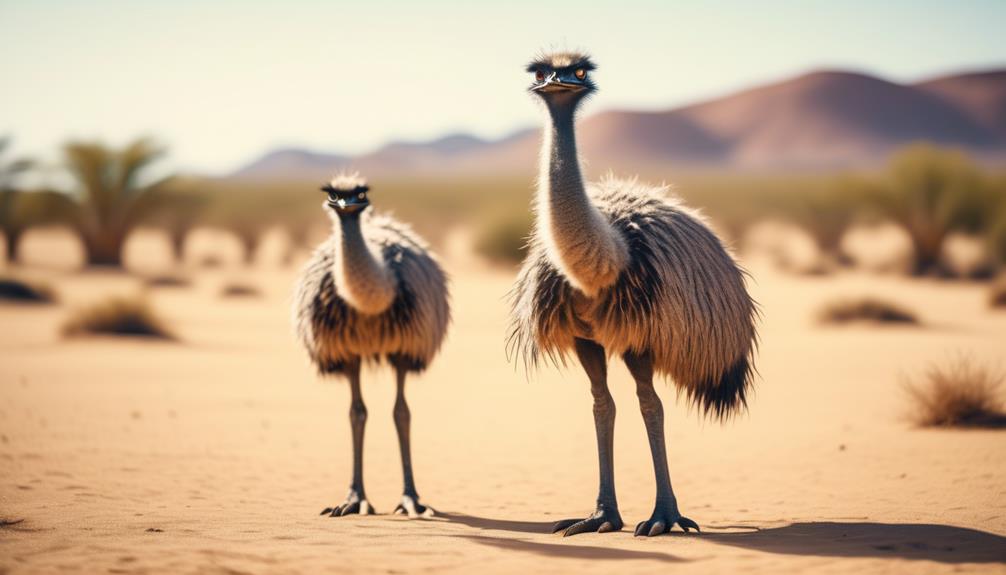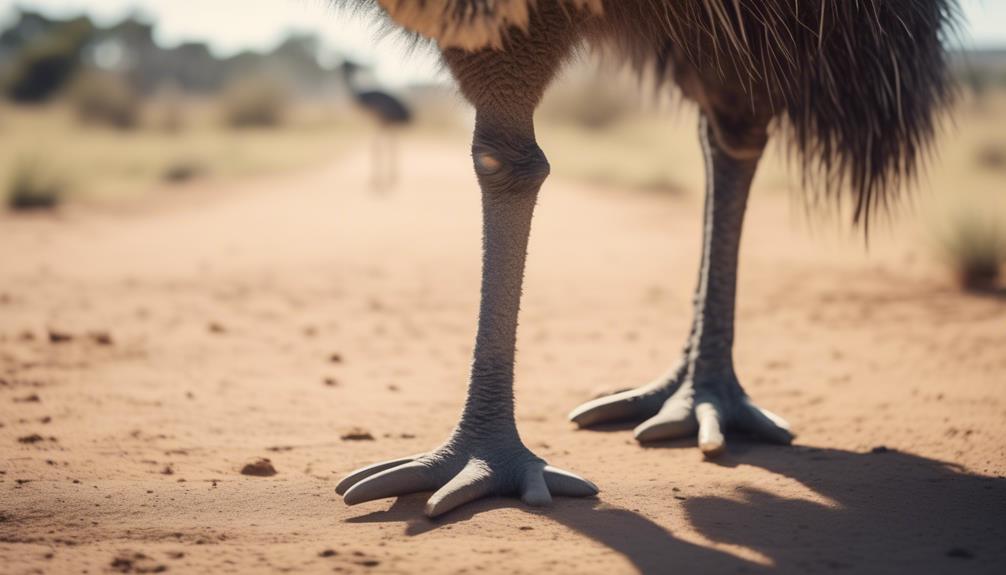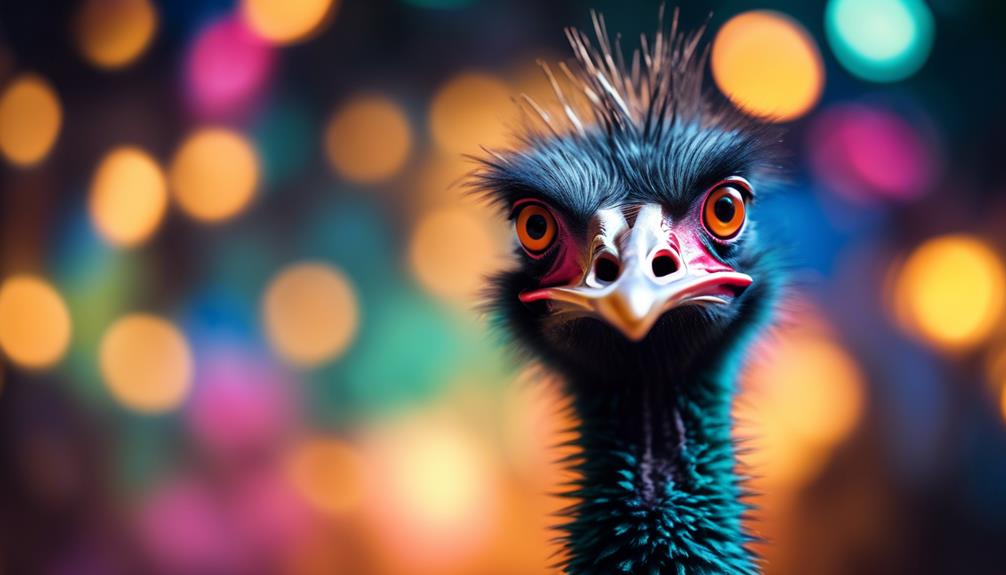
Step into the vast and intriguing world of emu birds, where myths and facts intertwine like the feathers on their magnificent wings.
These enigmatic creatures, known for their flightless nature, have captured the curiosity of many. But how much do you really know about emus?
It's time to separate fact from fiction, to unveil the truth behind the common misconceptions that have clouded our understanding.
Prepare to have your preconceived notions challenged as we journey through the fascinating realm of emu birds.
Are you ready to discover the secrets that lie beneath the surface?
Key Takeaways
- Emus cannot fly due to unique physiological adaptations, such as large wingspans and strong muscles, but they primarily use their wings for balance and stability while running.
- Emus are omnivorous birds with a varied diet, and they use their long beaks to peck at the ground and swallow small stones to aid digestion.
- Male emus build nests and incubate the eggs during the breeding season, contrary to the myth that they bury their heads in the sand.
- Emus pose no inherent danger to humans and are known to be gentle and curious creatures, but it is important to approach them with caution and respect their space.
Emus Cannot Fly
Emus, fascinating flightless birds native to Australia, are unable to fly due to their unique physiological adaptations. Despite their large wingspan and strong muscles, emus have evolved in a way that prevents them from taking flight. In the wild, emus use their wings primarily for balance and stability while running at high speeds. Their small, vestigial wings are no longer capable of generating enough lift to allow them to become airborne.
In addition to their inability to fly, emus also possess other adaptations that further support their ground-dwelling lifestyle. For instance, they've long, powerful legs that enable them to run at speeds of up to 30 miles per hour, making them one of the fastest birds on land. Their strong legs and three-toed feet, equipped with sharp claws, allow them to navigate diverse terrains such as forests, grasslands, and deserts.
While some people may be captivated by the idea of having an emu as a pet, it's important to note that emus aren't suitable for domestication. Their large size, strong instinctual behavior, and specific dietary needs make them challenging to care for in a home environment. Emus are wild animals that thrive in their natural habitats, where they can freely roam and express their unique behaviors.
Emus Are Not Aggressive
With their non-aggressive nature being a notable characteristic, emus exhibit behaviors that differ greatly from their inability to fly. Contrary to popular belief, emus aren't aggressive creatures. In fact, they're known for their calm and docile temperament, making them suitable for interaction in captivity. Here are some facts that debunk the common misconception of emus being aggressive:
- Social Behavior: Emus are highly social animals, often found in groups called mobs. They establish hierarchies within these groups through gentle interactions, such as head nodding and vocalizations. Aggressive encounters among emus are rare and usually limited to territorial disputes or mating rituals.
- Protective Parenting: Emus are exceptional parents and display protective behavior towards their offspring. Male emus take on the responsibility of incubating the eggs and raising the chicks. They're fiercely defensive when it comes to safeguarding their young, but their defensive behavior isn't directed towards humans.
- Curiosity and Playfulness: Emus are naturally curious creatures and are often intrigued by their surroundings. They may approach humans out of curiosity but don't exhibit aggressive behavior unless provoked.
- Emu Eggs as a Food Source: While emu eggs are considered a delicacy in some cultures, the process of collecting them doesn't lead to aggression from the birds. Emus in captivity are accustomed to human presence and can be approached safely when gathering their eggs.
Understanding the non-aggressive nature of emus is crucial in dispelling misconceptions and promoting a more accurate perception of these fascinating birds.
Emus Do Not Bury Their Heads in the Sand

Contrary to popular belief, emus don't bury their heads in the sand. This myth likely originated from the observation that emus often lower their heads and necks to the ground. However, this behavior isn't an attempt to hide or bury their heads, but rather a natural feeding habit.
Emus are omnivorous birds and have a varied diet that consists of plants, insects, small vertebrates, and even carrion. To feed, emus use their long beaks to peck at the ground, searching for food. They can swallow small stones to help grind up food in their muscular gizzard. When an emu lowers its head to the ground, it's simply trying to reach closer to its food source, not bury its head in the sand.
During the breeding season, emus also exhibit unique mating behaviors. The male emu builds a nest by scraping out a shallow depression in the ground and lining it with leaves and grass. The female emu then lays her eggs in the nest and it's the male who takes responsibility for incubating the eggs. This behavior is quite the opposite of burying their heads in the sand, as the male emu diligently tends to the nest and guards the eggs until they hatch.
Emus Are Not Completely Flightless
Although emus are known for their large size and inability to fly, they aren't completely flightless creatures. Contrary to popular belief, emus possess certain abilities that allow them to navigate through different terrains and even water. Here are some fascinating facts about emus that might surprise you:
- Emus can swim: While they may not have the ability to soar through the skies, emus are actually proficient swimmers. Their long, powerful legs and webbed feet enable them to paddle through water with ease. This skill comes in handy when they encounter bodies of water during their journeys.
- Emus are fast runners: Emus are well-known for their remarkable running capabilities. With their strong legs and agile bodies, they can reach speeds of up to 30 miles per hour. This incredible speed allows them to outrun many predators and escape dangerous situations.
- Emus have vestigial wings: Despite their inability to fly, emus still possess wings. However, these wings are greatly reduced in size and are more akin to small, vestigial structures. They serve as a balance aid while the bird is running and contribute to its overall agility.
- Emus have adaptations for flightlessness: Emus have evolved certain adaptations that compensate for their inability to fly. Their bodies are lightweight and streamlined, allowing for efficient movement on land. Additionally, their feathers are specially designed to reduce drag and maintain insulation, enhancing their ability to survive in various climates.
Emus Have Two Toes, Not Three

Emus possess a unique characteristic that sets them apart from many other birds – they've two toes instead of the typical three. This distinct feature is a result of their evolutionary adaptation to their environment. Emu bird anatomy plays a critical role in their behavior and survival.
The two toes of emus are long and strong, designed for running rather than flying. These toes are equipped with sharp claws that allow emus to defend themselves against predators and grasp objects with precision. Their powerful legs, which support their large, stout bodies, enable them to reach impressive speeds of up to 30 miles per hour while running.
The reduced number of toes in emus is advantageous in their natural habitat. With only two toes, emus have a wider, more stable base of support, enhancing their agility and balance. This adaptation allows them to navigate various terrains, including grasslands, woodlands, and even deserts, with ease.
Emus use their two-toed feet to explore their surroundings and forage for food. They're omnivorous birds, consuming a diverse diet that includes plants, insects, small animals, and even stones that aid in digestion. Their toes play a crucial role in their feeding behavior, enabling them to grasp and manipulate objects as they search for sustenance.
Emus Do Not Lay Green Eggs
In understanding the unique characteristics of emu birds, one notable aspect is their egg-laying process, which dispels the myth that emus lay green eggs. Emu eggs, like those of other bird species, come in a range of colors, but green isn't one of them.
Here are some key facts about emu egg color variations and egg-laying patterns:
- Emu eggs display a beautiful range of colors, including shades of blue, greenish-blue, and even dark olive.
- The color of an emu egg is determined by the pigments present in the eggshell, which are influenced by the genetics of the individual emu.
- The color variations in emu eggs serve as a form of camouflage, helping the eggs blend in with their surroundings and protect them from potential predators.
Emu birds are known for their unique egg-laying patterns. Unlike most birds that lay eggs in a nest, emus lay their eggs directly on the ground, making them vulnerable to predation. However, the male emu takes on the responsibility of incubating the eggs and caring for the chicks once they hatch.
Understanding the true color variations of emu eggs and their egg-laying patterns helps dispel the misconception of emus laying green eggs. Emus are fascinating creatures with unique characteristics that continue to captivate researchers and enthusiasts alike.
Emus Are Not Completely Silent

Contrary to popular belief, emus aren't completely silent creatures. While they may not sing like birds or roar like lions, emus do make distinct sounds to communicate with each other and express their emotions. These sounds, though not as melodious as those of songbirds, play an important role in the social dynamics of emu populations.
Emus communicate through a combination of vocalizations and body language. When feeling threatened or alarmed, emus emit a deep booming sound that can be heard from quite a distance. This low-frequency sound is produced by inflating their throat pouches and is often accompanied by a corresponding display of aggressive body language, such as fluffing up their feathers and erecting their necks.
In addition to their booming calls, emus also make soft grunting sounds during courtship and mating rituals. These vocalizations help to attract potential mates and establish dominance within the group. Emus also use body language, such as head bobbing and neck movements, to signal their intentions and convey their emotions.
Emus Do Not Have Sharp Claws
While emus may not be known for their sharp claws, they possess other unique characteristics that make them fascinating creatures. Emus are large, flightless birds native to Australia, and they've adapted to their environment in interesting ways.
Here are some key facts about emus that debunk the misconception about their lack of sharp claws:
- Emus have long, powerful legs that end in three-toed feet. These feet aren't equipped with sharp claws like those of birds of prey, but they're still formidable. Emus use their legs and feet for defense and can deliver powerful kicks when threatened.
- Emus are omnivores, meaning they've a flexible diet. Their feeding habits include eating a variety of plants, insects, small mammals, and even other birds' eggs. This diverse diet enables them to survive in different habitats and adapt to changing food availability.
- When it comes to reproductive behavior, emus exhibit fascinating rituals. During the breeding season, males will make deep, booming calls to attract females. Once a pair forms a bond, they'll engage in a unique dance where they twirl, fluff their feathers, and bob their heads. This elaborate courtship display helps establish pair bonds and ensure successful mating.
- Emus are known for their large, dark-green eggs, which are laid by the female and then incubated by the male. The male takes on the responsibility of incubating the eggs for around eight weeks, without eating or drinking. This behavior is quite remarkable and showcases the dedication and paternal instincts of male emus.
Emus Are Not Dangerous to Humans

Emus pose no inherent danger to humans, as their natural behavior isn't aggressive or threatening. In fact, they're known to be gentle and curious creatures. Despite their large size and powerful legs, emus rarely exhibit aggressive behavior towards humans unless they feel threatened or cornered. In the wild, emus are more likely to flee from humans rather than confront them.
This docile nature of emus has led to their increasing popularity as therapy animals. Many people find comfort and relaxation in their presence, as emus have a calming effect due to their gentle demeanor. They're also being considered as pets in some households, especially in rural areas where they've enough space to roam and forage.
While it's important to remember that all animals have the potential to become aggressive if provoked or mistreated, emus have shown no inherent inclination to harm humans. It's always advisable to approach emus with caution and respect their space, as with any wild or domesticated animal. By understanding their behavior and providing them with a suitable environment, emus can be kept safely and enjoyed as companions.
Emus Do Not Only Live in Australia
In exploring the global distribution of emus, it's fascinating to discover that these unique birds extend beyond the borders of Australia. While Australia is indeed their native home, emus have also been introduced to other countries where they've successfully established populations. Here are some interesting facts about emu distribution in other countries:
- United States: Emus were first imported to the United States in the 1930s for their meat and feathers. Today, they can be found in various states including Texas, California, and Florida.
- Canada: Emus were introduced to Canada in the 1990s as part of the ostrich farming industry. They're primarily found in British Columbia and Alberta.
- New Zealand: Emus were introduced to New Zealand in the 1860s as a potential source of feathers. They thrive in the country's diverse habitats, particularly in the North Island.
- Europe: Emus can also be found in some European countries, such as Germany, where they're kept in private collections and zoos.
Emu distribution in these non-native habitats has raised concerns about the conservation of the species. Efforts are being made to prevent the escape of emus into the wild and to regulate their breeding to avoid negative impacts on local ecosystems. By understanding the distribution and conservation needs of emus in these countries, we can work towards ensuring the long-term survival of these remarkable birds.
Emus Do Not Suffer From Loneliness

Research has shown that emus, despite their solitary nature, don't suffer from loneliness. Contrary to popular belief, emus don't require human companionship to thrive. Emus are social animals, but their socialization primarily occurs within their own kind. In the wild, emus form loose social groups called mobs, consisting of several individuals. These mobs provide opportunities for emus to interact, communicate, and establish hierarchies.
Emus have evolved to be independent and self-sufficient. They've adapted to harsh environments, where they must rely on their own instincts and abilities for survival. Emus possess a unique set of behaviors and adaptations that allow them to navigate their surroundings and meet their needs without the need for constant social interaction.
While emus may not seek out human companionship, it's essential to provide them with appropriate socialization with other emus. This can be achieved by ensuring that emus are housed in suitable groupings, allowing them to engage in natural behaviors and establish social bonds.
Frequently Asked Questions
Do Emus Have Any Predators in the Wild?
Emus, in the wild, have natural enemies or predators. These include dingoes, wedge-tailed eagles, and feral pigs. These animals play a crucial role in the ecosystem by preying on emus for food.
How Long Do Emus Typically Live in Captivity?
In captivity, emus typically live for about 10 to 20 years. However, their lifespan in the wild is shorter due to various factors such as predation, disease, and environmental conditions. So, if you're interested in emu breeding habits, understanding their lifespan is crucial.
Can Emus Swim?
Emus and water, an intriguing relationship. Can emus swim? While they can't dive like ducks, emus are surprisingly adept swimmers, using their long legs and powerful strokes to navigate through water.
Are Emus Social Animals That Live in Groups?
Do emus live in groups? Yes, emus are social animals that typically live in small family groups. They have complex breeding habits and use vocalizations and body language for communication within their group.
What Is the Primary Diet of Emus in the Wild?
Emus are primarily herbivorous, with their diet consisting of a variety of plants, seeds, fruits, and flowers. Their foraging behavior allows them to efficiently search for food, making them adaptable and successful in finding nourishment in the wild.
Conclusion
In conclusion, debunking the myths about emu birds reveals their fascinating nature. Despite their inability to fly, emus aren't aggressive or dangerous to humans. Contrary to popular belief, they don't bury their heads in the sand and aren't completely flightless. With two toes instead of three and no sharp claws, emus prove to be gentle creatures.
These misunderstood birds can be found beyond Australia, and they don't suffer from loneliness. Emu birds are truly remarkable, deserving of appreciation and understanding.





